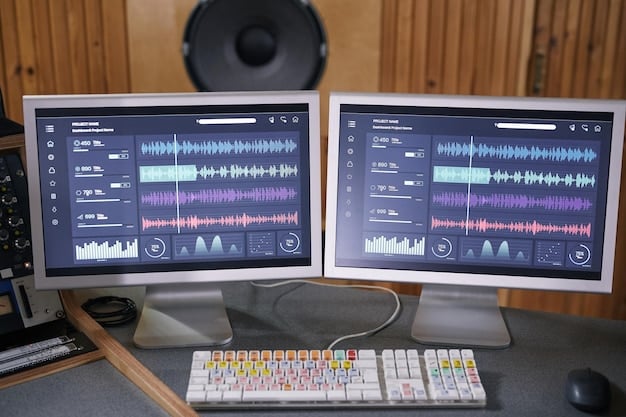Earn Passive Income: Royalties Guide for US Music, Art & Inventions

Earning passive income from royalties in the US involves licensing your intellectual property, such as music, art, or inventions, allowing others to use it in exchange for a percentage of the revenue generated.
Looking for ways to generate income even while you sleep? Discover how to earn passive income from royalties: a guide to licensing your music, art, or inventions in the US. This comprehensive guide provides the insights you need to turn your creative work into a steady stream of revenue.
Understanding Royalties: A Path to Passive Income
Royalties represent a percentage of revenue paid to the owner of an asset for the right to use it. This can be music, a book, a brand name, or even a patent. For creators and inventors, royalties offer a powerful way to earn passive income from royalties: a guide to licensing your music, art, or inventions in the US, without actively selling or managing their creations on a daily basis.
There are several types of royalties, each applicable to different kinds of intellectual property. Identifying the right type of royalty agreement is crucial for maximizing your earning potential.
Types of Royalties
Understanding the different types of royalties is the first step in leveraging your intellectual property for passive income. Here’s a brief overview:
- Mechanical Royalties: These are generated from the reproduction and distribution of copyrighted musical compositions. Every time a song is physically reproduced (like on a CD) or digitally distributed (through downloads or streaming), a mechanical royalty is owed to the songwriter and publisher.
- Performance Royalties: These royalties are paid to songwriters and publishers when their music is performed publicly. This includes radio airplay, live performances, and streaming on platforms like Spotify or Apple Music.
- Synchronization Royalties: These are paid when a song is synchronized with visual media, such as movies, TV shows, commercials, or video games. This type of royalty can be quite lucrative, especially for songs that are featured in popular productions.
- Print Royalties: These are generated from the sale of printed music, such as sheet music or songbooks. While less common in the digital age, print royalties can still be a source of income for musicians.
Successfully navigating the world of royalties requires understanding these different types and how they apply to your specific situation. This knowledge empowers you to protect your rights and optimize your income streams.
In conclusion, royalties provide a versatile avenue for creators and inventors to monetize their work, offering both financial rewards and the freedom to focus on future projects. Fully understanding these different types of incomes can boost your ability to earn passive income from royalties: a guide to licensing your music, art, or inventions in the US.
Licensing Your Music for Royalties in the US
The music industry thrives on licensing, allowing songwriters, composers, and publishers to earn royalties. Licensing your music involves granting permission to others to use your copyrighted work in various ways, such as reproduction, distribution, performance, or synchronization. Proper licensing is key to earn passive income from royalties: a guide to licensing your music, art, or inventions in the US.
Navigating the complexities of music licensing can seem daunting, but understanding the fundamental steps is essential for protecting your work and maximizing your royalty income.

Steps to License Your Music
Effectively licensing your music involves a series of strategic steps, each designed to protect your rights and ensure you receive fair compensation. Here’s a detailed breakdown:
- Copyright Your Music: The first step is to officially copyright your music with the U.S. Copyright Office. This establishes your legal ownership of the work and gives you the right to control how it’s used.
- Join a Performing Rights Organization (PRO): PROs like ASCAP, BMI, and SESAC collect performance royalties on behalf of songwriters and publishers. By affiliating with a PRO, you can ensure you receive royalties whenever your music is performed publicly.
- Register Your Songs with Harry Fox Agency (HFA): HFA is a leading mechanical licensing administrator in the U.S. Registering your songs with HFA makes it easier for others to obtain mechanical licenses for your work.
- Negotiate License Agreements: When someone wants to use your music, you’ll need to negotiate a license agreement that specifies the terms of use, the royalty rate, and any other relevant conditions. It’s helpful to consult with a music attorney to ensure you get a fair deal.
Proper licensing is essential for protecting your rights. By following these steps, you can effectively license your music and ensure you receive the royalties you deserve.
In summary, licensing your music involves several key steps, from copyrighting your work to negotiating license agreements. These ensure that you earn passive income from royalties: a guide to licensing your music, art, or inventions in the US, effectively and legally.
Turning Art into Passive Income: Licensing Visual Creations
Visual artists can also tap into passive income streams by licensing their artwork. Whether you’re a painter, photographer, illustrator, or graphic designer, licensing allows you to grant others the right to use your images or designs in exchange for royalties. Mastering this can help you earn passive income from royalties: a guide to licensing your music, art, or inventions in the US.
Licensing your visual creations can open up new revenue streams and allow you to reach a wider audience without relinquishing ownership of your work.
- Stock Photography and Illustration: Platforms like Shutterstock, Getty Images, and Adobe Stock allow you to upload your photos and illustrations for licensing. Customers can purchase licenses to use your images in their projects, and you earn a royalty for each sale.
- Art Prints and Merchandise: You can license your artwork to companies that produce art prints, posters, and merchandise like mugs, t-shirts, and phone cases. This allows you to reach a broader market without handling the production and fulfillment yourself.
- Design Templates and Resources: Graphic designers can license their design templates, icons, and other resources on platforms like Creative Market and Envato Elements. This can provide a steady stream of royalty income as customers use your resources in their projects.
Exploring these avenues can significantly boost your passive income. This is a great way to earn passive income from royalties: a guide to licensing your music, art, or inventions in the US.
In conclusion, licensing your art is a viable avenue that opens up passive income opportunities for visual artists. There are many potential benefits waiting to be unlocked.
Patents and Royalties: Monetizing Your Inventions
If you’re an inventor, patents can be a goldmine for generating passive income. A patent grants you exclusive rights to your invention, preventing others from making, using, or selling it without your permission. Licensing your patent allows you to earn passive income from royalties: a guide to licensing your music, art, or inventions in the US, by allowing others to commercialize your invention while you receive a percentage of the profits.
Patent licensing can be a complex but highly rewarding process. Understanding the key steps involved is crucial for maximizing your earning potential.
Steps in Patent Licensing
Successfully licensing your patents involves a thorough process, from protecting your invention to negotiating favorable terms. Here’s an outline of the key steps involved:
- Secure a Patent: The first step is to obtain a patent from the U.S. Patent and Trademark Office (USPTO). This requires submitting a detailed application that describes your invention and its unique features.
- Identify Potential Licensees: Research companies in your industry that could benefit from your invention. Look for companies that have the resources and expertise to commercialize your technology.
- Develop a Licensing Strategy: Determine the type of license you want to offer (exclusive or non-exclusive), the royalty rate you’ll charge, and any other terms you want to include in the agreement.
- Negotiate License Agreements: Once you’ve identified potential licensees, you’ll need to negotiate a license agreement that specifies the terms of use, the royalty rate, and any other relevant conditions. It’s helpful to consult with a patent attorney to ensure you get a fair deal.
This process requires patience and preparation but can result in high potential. This is a great way to earn passive income from royalties: a guide to licensing your music, art, or inventions in the US.
In conclusion, patents are a significant avenue for inventors to monetize their innovations, and the right licensing strategy can unlock substantial returns.
Negotiating Royalty Agreements: Key Considerations
Negotiating royalty agreements is a critical step in ensuring you receive fair compensation for the use of your intellectual property. Whether you’re licensing music, art, or inventions, understanding the key considerations and negotiating effectively can significantly impact your income stream. This skill is vital to earn passive income from royalties: a guide to licensing your music, art, or inventions in the US.
A well-negotiated agreement protects your rights, defines the terms of use, and sets the stage for a mutually beneficial partnership.
- Royalty Rate: Royalty rate is the percentage of revenue that you will receive and it varies depending on the industry, the type of property, and the scope of the agreement. Research the market standards to ensure that your royalty rates are appropriate.
- Advance Payments: Consider negotiating an advance payment against future earnings. This can provide you with upfront capital to support your creative work or offset the costs associated with protecting your intellectual property.
- Term of Agreement: The term of agreement stipulates how long the licensee is allowed to use your property and is an important clause as well. Ensure the terms stated will be beneficial in both the short-term and long-term.
Negotiating can be daunting but is a vital skill to learn to ensure a long-term partnership. Mastering this can ensure you earn passive income from royalties: a guide to licensing your music, art, or inventions in the US.
In summary, negotiating royalty agreements is critical to making sure that you receive fair compensation for your intellectual property. It is critical to have a strong and well-negotiated agreement to protect you and help you succeed.

Protecting Your Intellectual Property: Legal and Practical Steps
Protecting your intellectual property is paramount to safeguarding your royalty income. Copyright laws, patent laws, and trademark laws provide legal frameworks for protecting your creative works and inventions. Taking proactive steps to register and enforce your rights is essential to earn passive income from royalties: a guide to licensing your music, art, or inventions in the US.
Protecting your intellectual property is an ongoing effort that requires vigilance and proactive measures.
Essential Protective Steps
Safeguarding your intellectual property involves a combination of legal and practical measures. Here are some essential steps to consider:
- Register Your Copyrights, Patents, and Trademarks: Registering your intellectual property with the appropriate government agencies establishes your legal ownership and provides you with the right to sue infringers.
- Use Watermarks and Copyright Notices: Adding watermarks to your images and including copyright notices on your works can deter unauthorized use and make it easier to enforce your rights.
- Monitor for Infringement: Regularly monitor the internet and other sources for unauthorized use of your intellectual property. There are tools and services available that can help you track down infringers.
- Enforce Your Rights: If you discover someone is infringing on your intellectual property rights, take prompt action to enforce your rights. This may involve sending a cease-and-desist letter, filing a lawsuit, or pursuing other legal remedies.
In conclusion, protecting your IP is highly important so you can be successful in making passive income. Following these steps and taking it seriously is the key to earn passive income from royalties: a guide to licensing your music, art, or inventions in the US.
Managing and Maximizing Your Royalty Income
Once you start earning royalties, it’s essential to manage your income effectively and explore ways to maximize your earnings. This involves keeping track of your royalty statements, understanding your tax obligations, and identifying new licensing opportunities. These are key elements to earn passive income from royalties: a guide to licensing your music, art, or inventions in the US.
Effective management ensures you keep more of what you earn, while strategic maximization efforts can help you grow your income stream over time.
- Keep Detailed Records: Keep careful records of all your licensing agreements, royalty statements, and related expenses. This will make it easier to track your income, file your taxes, and identify any discrepancies in your royalty payments.
- Understand Your Tax Obligations: Royalty income is generally taxable, so it’s essential to understand your tax obligations and plan accordingly. Consult with a tax advisor to discuss your specific situation and ensure you’re meeting all your obligations.
- Explore New Licensing Opportunities: Continuously look for new licensing opportunities to expand your income stream. This may involve reaching out to new potential licensees, attending industry events, or partnering with licensing agents to promote your work.
With strong management, you will be able to increase the profitability of your income stream. This is the final step to fully earn passive income from royalties: a guide to licensing your music, art, or inventions in the US.
In conclusion, to maximize your royalty income, it is vital to manage and take the proper steps. This can ensure that your passive income stream continues to grow in the future.
| Key Point | Brief Description |
|---|---|
| 🎵 Licensing Music | Copyright your music and join PROs like ASCAP to earn royalties. |
| 🎨 Licensing Art | Use stock platforms or merchandise to license your visual creations. |
| 💡 Patenting Inventions | Secure a patent with USPTO and identify potential licensees for your inventions. |
| 🤝 Negotiating Agreements | Ensure royalties are fair by researching market standards and considering advance payments. |
Frequently Asked Questions (FAQ)
▼
A royalty is a payment made to the owner of intellectual property for the right to use their asset. This can include music, art, patents, and trademarks. It enables creators to earn income without actively selling or managing their creations.
▼
You can protect your intellectual property by registering copyrights for your creative works, obtaining patents for your inventions, and registering trademarks for your brand names. Take all necessary steps to secure your inventions.
▼
A PRO, such as ASCAP, BMI, or SESAC, collects performance royalties on behalf of songwriters and publishers. By joining a PRO, you can ensure you receive royalties whenever your music is performed publicly.
▼
Negotiating a royalty agreement involves determining the royalty rate, the term of the agreement, and any advance payments. It’s helpful to research market standards so you can ensure your royalty rates are appropriate.
▼
Common mistakes include failing to register your IP, not monitoring for infringement, and not understanding the tax implications of royalty income. Make sure that you have the proper knowledge and get help from professionals.
Conclusion
Earning passive income through royalties presents an appealing avenue for creators and inventors in the US, offering a blend of financial reward and creative freedom. By understanding the intricacies of licensing music, art, and inventions, individuals can unlock new revenue streams and turn their intellectual property into long-term assets.





